Water & Carbon Cycle
1/79
There's no tags or description
Looks like no tags are added yet.
Name | Mastery | Learn | Test | Matching | Spaced |
|---|
No study sessions yet.
80 Terms
What is a system?
A set of interrelated components working together.
What are systems composed of?
Inputs - where matter or energy is added to the system.
Outputs - where matter or energy leaves the system.
Stores/Components - where matter or energy builds up in the system.
Flows/Transfers - where matter or energy moves from one store to another.
Boundaries - the limits of the system.
What are the 3 types of systems?
Open - (energy & matter exchanged)
Closed - (only energy exchanged)
Isolated - (no exchange)
What is dynamic equilibrium?
Is where a systems inputs & outputs are balanced (small changes can occur eg. amount of precipitation entering a drainage basin constantly varies, but on average the system remains balanced).
What is feedback?
Is the way a system responds to a change in inputs or flows, either amplifying or nullifying the initial change.
Why can Earth be seen as a closed system?
Energy is input from the sun & output to space, but matter (water, carbon) is not input & out[ut (expect the odd space probe)
What is a subsystem?
Subsystems are smaller systems (e.g., carbon cycle) that interact within Earth’s larger spheres (lithosphere, atmosphere).
What are the Earth’s subsystems & definitions?
Atmosphere (air)
Biosphere (living things)
Lithosphere (rocks/soil)
Hydrosphere (water)
Cryosphere (ice)
What is a cascading system?
Where one system’s output becomes another’s input
What are the water & carbon cycles on a local & global scale?
Local Scale: Open Systems
Global Scale: Closed Systems
What is the global hydrological cycle?
The continuous movement of water between stores (oceans, air, land) via processes (evaporation, precipitation) & is a closed system.
Define blue water & green water flows.
Blue: Liquid water in rivers, lakes, groundwater.
Green: Water stored in soil/plants (used by vegetation).
What are the main stores of water in the hydrological cycle?
Earth’s Water: oceans 97%, freshwater 3%
Freshwater: ice caps+ glaciers 79%, 20% groundwater, easily accessible freshwater 1%
Easily Accessible Freshwater: lakes 52%, 38% soil moisture, water vapour 8%, rivers 1%, water in living things 1%
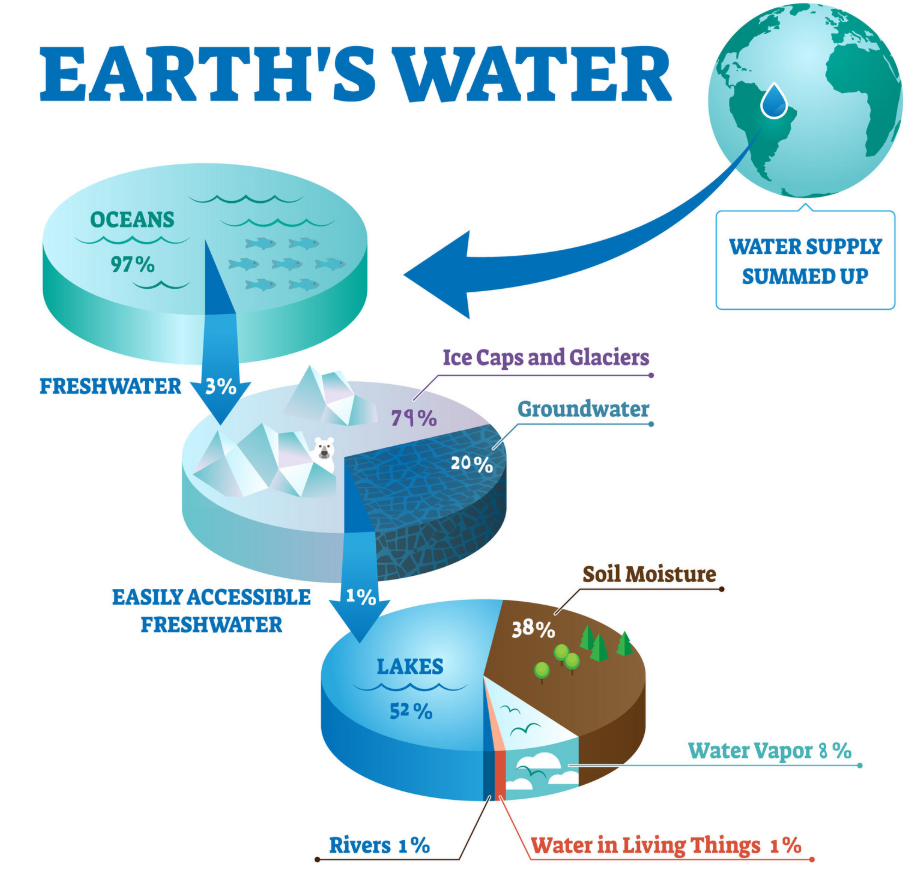
What are the main types of water & stores in the subsystems?
Atmosphere: Water vapor, clouds.
Biosphere: Water contained in plants and animals.
Lithosphere: Groundwater and aquifers.
Hydrosphere: Oceans and surface water.
Cryosphere: Ice sheets and permafrost.
What are the processes driving change in major water stores?
Evaporation
Condensation (Cloud Formation & Precipitation)
Cryospheric Processes
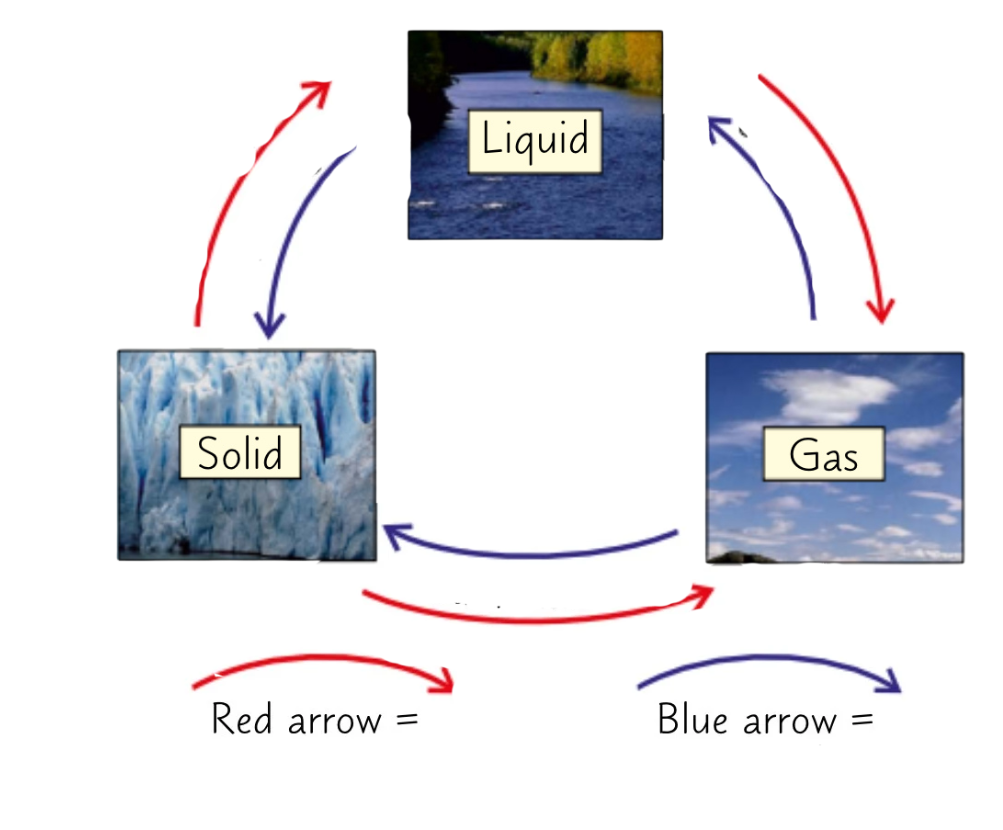
Label the states diagram
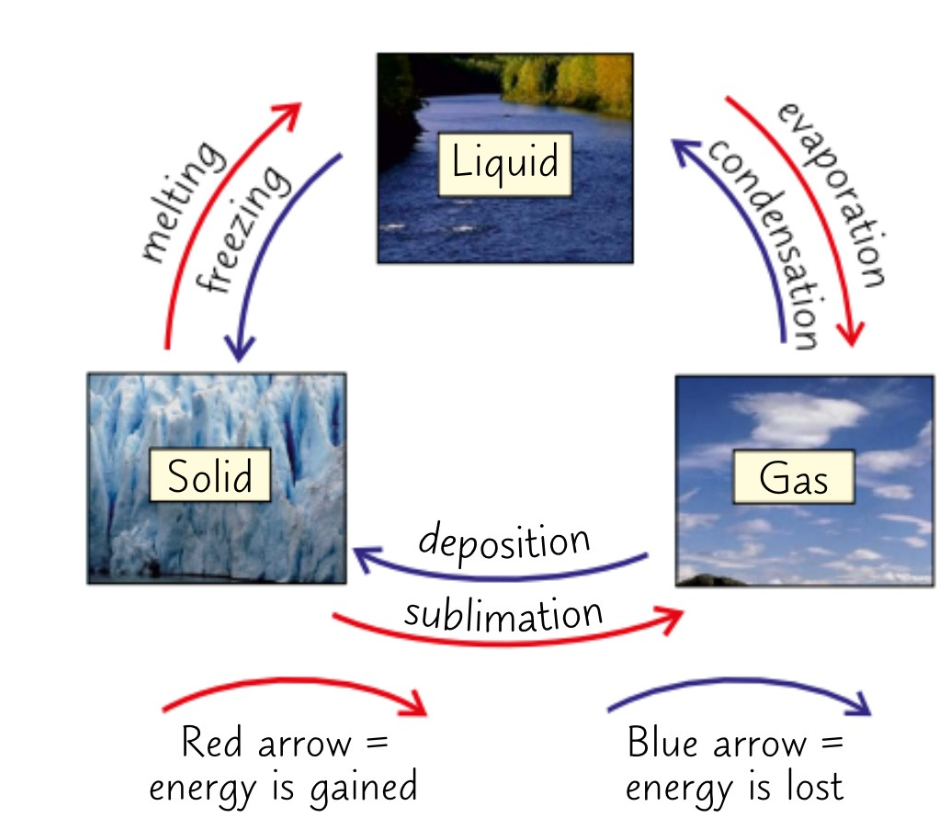
Define:
Evaporation
Condensation
Melting
Freezing
Sublimation
Deposition
Process | Phase Change | Latent Heat | Example |
|---|---|---|---|
Evaporation | Liquid → Vapour | Absorbed | Ocean → Clouds |
Condensation | Vapour → Liquid | Released | Cloud formation |
Melting | Solid → Liquid | Absorbed | Glacial melt |
Freezing | Liquid → Solid | Released | Lake freezing |
Sublimation | Solid → Vapour | Absorbed | Dry ice disappearing |
Deposition | Vapour → Solid | Released | Frost on grass |
What is the process of evaporation?
Solar energy heats water → molecules escape as water vapour (absorbs latent heat energy → cooling surroundings)
What are the factors affecting evaporation?
Solar radiation
Temperature (cold air = less water vapour & warm air = more water vapour)
Humidity (saturated air = less evaporation & unsaturated air = more evaporation)
Wind speed
Surface area
Water availability (eg. more evaporation from a pond than a grassy field)
Season/daylight
Water salinity (saline water = slower evaporation compared to freshwater)
What is Potential Evapotranspiration (PET)?
The maximum amount of water that could evaporate/transpire from a surface if water supply were unlimited. Measured in mm/day or mm/year. eg.
PET = "Demand" (e.g., desert PET = 3000mm/yr).
Actual = "Supply-limited" (desert actual ≈ 50mm/yr due to no water).
What controls PET, and how does it differ from actual evaporation?
Solar radiation (main driver)
Temperature
Wind speed
Humidity (lower = higher PET)
Day length/seasons
What is the process of transpiration?
Plants absorb water via roots → release vapour through stomata.
What are the factors affecting transpiration?
Light ↑ (stomata open for photosynthesis)
Temperature ↑ (increases molecular activity)
Humidity ↓ (dry air = greater vapor gradient)
Wind ↑ (removes humid air near leaves)
Soil moisture ↓ (if too low, stomata close)
What is the process of evapotranspiration?
Evaporation + transpiration from land surfaces.
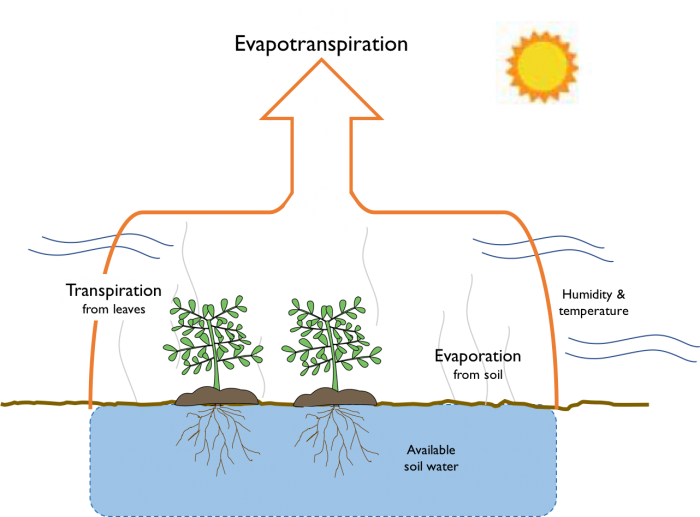
What is the dew point?
The temperature at which air becomes saturated (100% relative humidity), causing water vapour to condense into dew/frost.
What is saturated & unsaturated air?
Saturated: Air at dew point (max water vapour). Further cooling → condensation.
Unsaturated: Below dew point. Can absorb more vapour before condensing.
Why does cold air hold less water then warm air?
Warm air molecules move fast → keep vapour dispersed.
Cold air molecules slow → vapour condenses.
What is adiabatic cooling & warming?
Cooling: Rising air expands → temperature drops (e.g., clouds over mountains).
Warming: Sinking air compresses → temperature rises (e.g., desert formation).
What are low & high pressure systems?
Low Pressure Systems: Areas where air rises → adiabatic cooling → cloud formation and precipitation (cyclones & storms)
High Pressure Systems: Areas where air sinks → adiabatic warming → clear skies & stable weather conditions (heatwaves & deserts)
What is the process of condensation?
Water vapour cools to dew point → condenses onto nuclei (dust/salt) → forms droplets (clouds/dew).
What are condensation nuclei & aerosols?
Nuclei: Particles (dust, salt) that water condenses onto to form droplets.
Aerosols: All airborne particles (includes nuclei + non-nuclei like soot).
What is the process of precipitation?
Cloud droplets coalesce (merge) or ice crystals grow → too heavy → fall as rain, snow or hail.
What are the different types of rainfall?
Relief/Orographic: Rainfall resulting from moist air being forced to rise over mountains, cooling and condensing.
Frontal: Rainfall that occurs when a warm air mass meets a cold air mass, causing the warm air to rise and cool.
Convectional: Rainfall caused by the heating of the Earth's surface, resulting in warm air rising, cooling, and condensing.
What is the process of cloud formation?
Warm air rises → cools until dew point → condenses on nuclei → clouds.
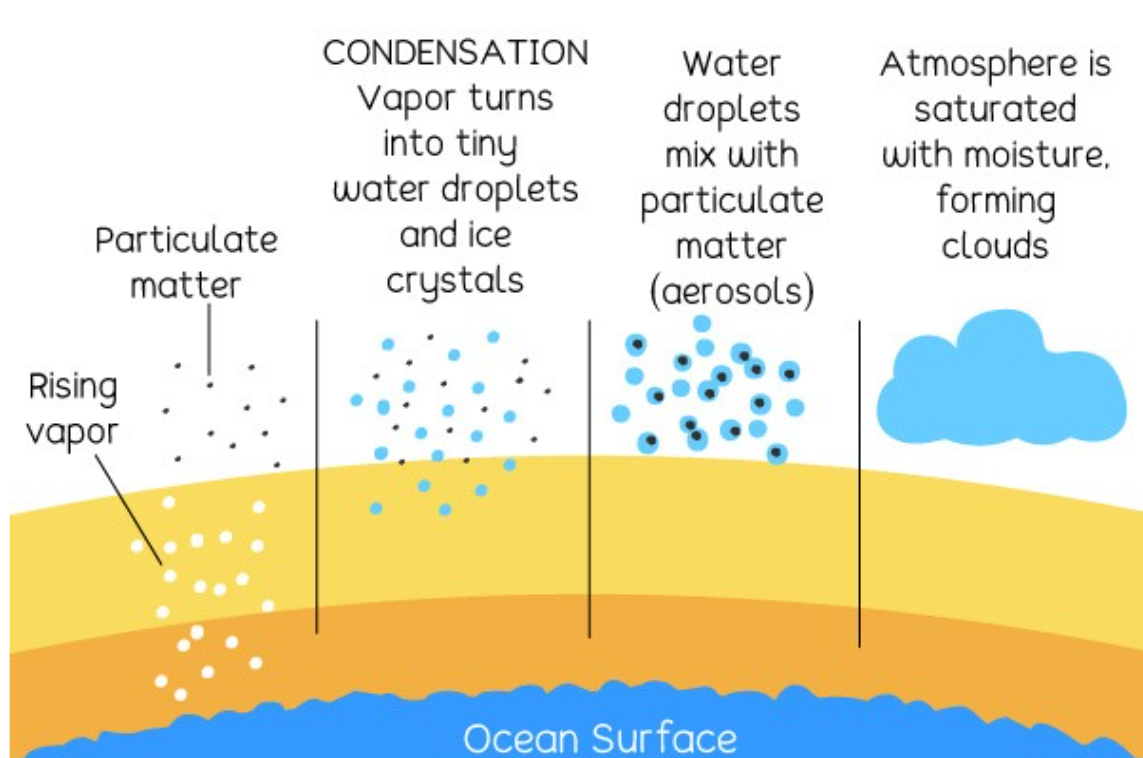
What is the process of fog formation?
Fog forms when near-surface air cools to its dew point (100% relative humidity), causing water vapour to condense into tiny suspended droplets.
What are the different types of fog?
Radiation Fog: Ground loses heat at night → chills adjacent air (common in valleys).
Advection Fog: Warm, moist air moves over cold surfaces (e.g., oceans or snow).
Upslope Fog: Air rises along slopes, cooling adiabatically.
What are cryospheric processes?
Accumulation (snowfall)
Ablation (melting)
Sublimation (ice to vapour)
Calving (icebergs breaking off).
What is a drainage basin?
Area of land where precipitation collects into a river system (open system)
What are the inputs, stores, flows and outputs of a drainage basin?
Inputs: Precipitation.
Stores: Interception storage, surface storage, soil water storage, groundwater storage, channel storage, vegetation storage.
Flows: Stem flow, through fall, surface runoff, infiltration, throughflow, interflow, percolation, groundwater flow, base flow, channel flow.
Outputs: Evaporation, transpiration, evapotranspiration, river discharge/river flow
Label the hill slope
What is the concept of water balance?
The equilibrium between water inputs, outputs, and storage changes in a system (e.g., drainage basin) over time.
What is the equation for water balance?
P = Q + E ± ΔS
P = Precipitation (input)
Q = Runoff (river discharge/output)
E = Evapotranspiration (output)
ΔS = Change in storage (soil, groundwater, snowpack)
Why does water balance matter?
Flood/Drought Prediction:
If P > (Q + E) → ΔS increases (groundwater recharge).
If P < (Q + E) → ΔS decreases (drought risk).
Human Impact:
Urbanisation ↑ Q (runoff) → ↓ ΔS (changes in storage)
Deforestation ↑ E (evapotranspiration) → alters balance.
What is a positive water balance?
When inputs exceed outputs → surplus water stored (P > Q + E)
What is a negative water balance?
When outputs exceed inputs → deficit water drawn from storage (P < Q + E)
Describe the UK’s water balance throughout the year.
Autumn (Sep-Nov): Recharge phase – Rainfall ↑, evapotranspiration (E) ↓ → groundwater & soil storage ↑.
Winter (Dec-Feb): Surplus – Peak rainfall/snow, low E → high runoff (flood risk).
Spring (Mar-May): Transition – Rainfall ↓, E ↑ → gradual storage drawdown.
Summer (Jun-Aug): Deficit – Low rainfall, high E → droughts (e.g., 2022 hosepipe bans).
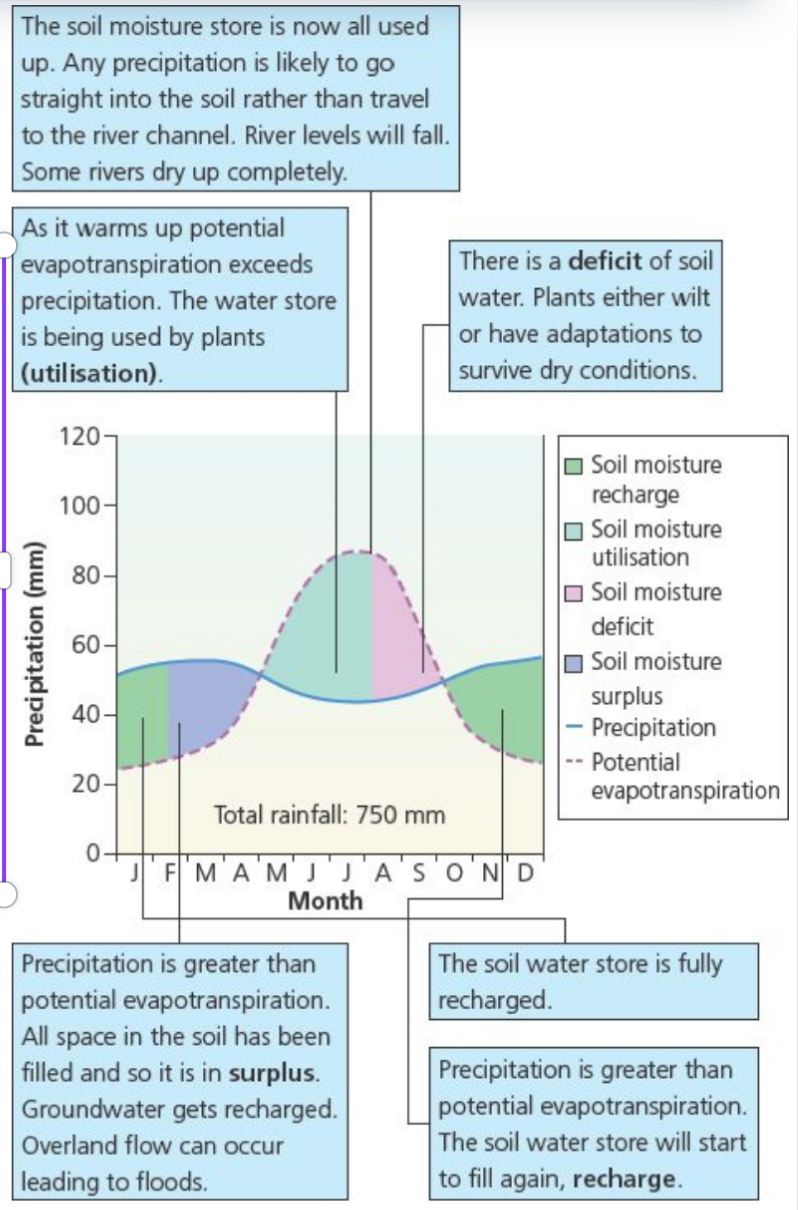
What is river discharge?
Volume of water flowing in a river channel at certain point in time measured in m³/s or cumecs.
How do you calculate river discharge?
Discharge (Q) = Cross-sectional Area (A) × Velocity (V)
Q = Discharge (m³/s or cumecs)
A = Width (m) × Mean Depth (m)
V = Flow velocity (m/s)
What is the soil moisture budget?
Balance between precipitation, evapotranspiration, and soil water storage.
Describe the UK’s soil moisture balance throughout the year.
Winter (Dec-Feb):
Surplus: High rainfall + low evapotranspiration (E) → soils saturated.
Risks: Waterlogging, runoff.
Spring (Mar-May):
Recharge declines: Rising E + steady rainfall → soils transition to field capacity (optimal moisture).
Summer (Jun-Aug):
Deficit: High E + low rainfall → soils dry out (wilting point reached in SE England).
Human response: Irrigation needed (e.g., East Anglian farms).
Autumn (Sep-Nov):
Recovery: Rainfall ↑ + E ↓ → soils replenish.
What is a river regime?
Annual variation in the amount of river discharge
What is a storm/flood hydrograph?
Graph showing river discharge before, during, and after rainfall.
Label the hydrograph.
Define the following:
Lag time
Base flow
Rising limb
Receding limb
Peak discharge
Storm flow
Bankfull discharge
Lag time: Delay between peak rainfall and peak discharge.
Base flow: Normal river flow (groundwater).
Rising limb: Increase in discharge after rain.
Receding limb: Decline in discharge.
Peak discharge: Highest flow rate.
Storm flow: Surface runoff + throughflow.
Bankfull discharge: River fills channel completely.
What are the characteristics of flashy vs. subdued hydrographs?
Flashy - short lag time, high peak discharge, steep rising & falling limbs (urban areas)
Subdued - long lag time, low peak discharge, gentle rising & falling limb (forested areas)
What are the natural & human factors affecting a storm hydrograph?
Natural Factors:
Size of Drainage Basin
Density of Drainage Basin
Shape of Drainage Basin
Topography (slope) of Drainage Basin
Vegetation
Geology
Saturation Levels by Antecedent Conditions
Human Factors:
Deforestation
Afforestation
Urban Growth
Agriculture
Water Abstraction
River Basin Management
What are the short & long-term changes affecting the water cycle?
Short term changes:
Daily fluctuations in temperature & precipitation (storm events & droughts).
Seasonal changes.
Climate oscillations ( Indian Ocean Dipole (IOD), El Nino & La Nina).
Long term changes:
Milankovitch cycles.
Human activities.
Climate change.
How do daily temperature and precipitation changes affect the water cycle?
Daytime warming (↑ Evaporation → from soil, water bodies &
↑ Transpiration → plants lose more water)
Nighttime cooling (↓ Air moisture capacity → condensation → dew/frost)
Storm events (↑ Surface runoff → saturated soils & ↓ Infiltration → short-term waterlogging)
Droughts (↓ Soil moisture → ↑ water stress for plants)
How do seasonal changes affect the water cycle?
1. Winter (Dec-Feb in UK)
↑ Precipitation → ↑ runoff & groundwater recharge.
↓ Evapotranspiration → cold temps → plants dormant, less evaporation.
Water Surplus → soils saturated → higher river discharge (flood risk).
2. Spring (Mar-May)
Balanced Phase:
Rainfall continues but ↑ evapotranspiration as plants grow.
Soil moisture reaches field capacity (optimal for crops).
3. Summer (Jun-Aug)
↓ Precipitation: High-pressure systems dominate.
↑↑ Evapotranspiration: Warm temps + active plants → rapid water loss.
Water Deficit: Soils dry out → droughts, irrigation demand.
4. Autumn (Sep-Nov)
Recovery Phase:
Rainfall returns, temps drop → ↓ evapotranspiration.
Soils and groundwater begin recharging.
How do climate oscillations affect the water cycle?
Climate oscillations disrupt global precipitation patterns and water storage by altering atmospheric and oceanic circulation.
What is a normal year?
Trade winds blow from east to west → driven by earths rotation or uneven heating atmosphere
Warm surface water is pushed west & cold upwelling in east
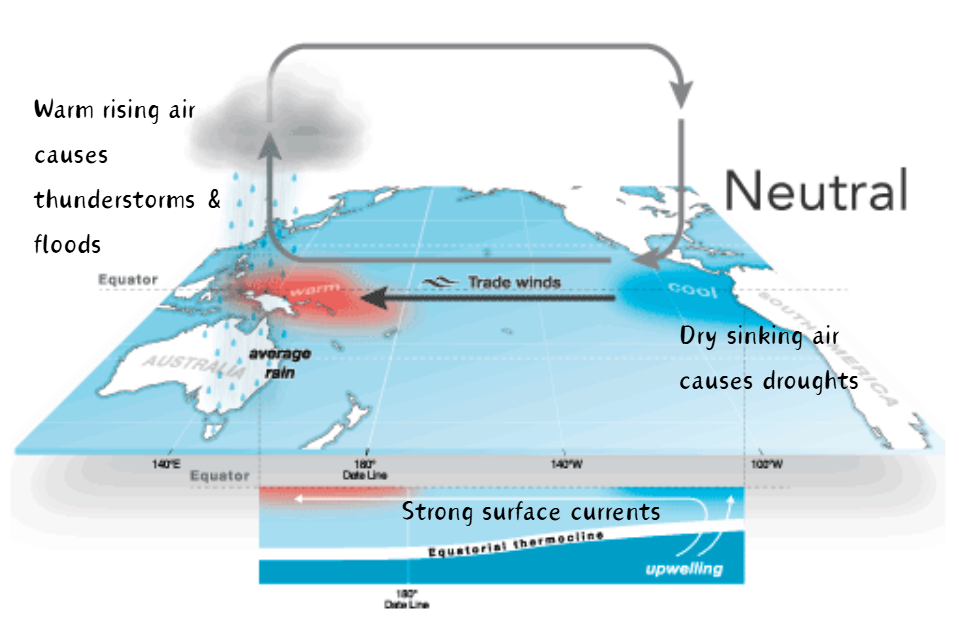
What is El Nino?
Trade winds weaken or reverse → warm water shifts eastwards.
↑ Sea temps in E. Pacific → droughts in Australia/SE Asia (↓ rainfall).
↑ Flooding in Americas (e.g., Peru, California).

What is La Nina
Trade winds strengthen → warm water shifts more westwards.
↑ Upwelling in E. Pacific → wetter SE Asia/Australia
Drier in Americas (e.g., Peru, California).

What is Indian Ocean Dipole (IOD)?
Positive IOD:
SSTs: West (Africa) warmer, East (Australia) cooler.
Impacts:
Australia: Droughts (2019 fires).
East Africa: Floods.
India: Weak monsoon.
Negative IOD:
SSTs: West cooler, East warmer.
Impacts:
Australia: Floods (2021 NSW).
East Africa: Droughts.
India: Strong monsoon.
How do Milankovitch Cycles affect the water cycle?
Milankovitch Cycles alter solar radiation distribution over 10,000–100,000 years, driving long-term shifts in the water cycle:
Eccentricity (100,000 yrs):
Earth’s orbit changes from circular → elliptical.
Impact: Extreme elliptical orbits → stronger seasons → polar ice melt/growth → sea level changes.
Obliquity (41,000 yrs):
Axial tilt varies (22.1°–24.5°).
Impact: Higher tilt → more extreme seasons → ↑ glacial melt (warm summers) or accumulation (cold winters).
Precession (26,000 yrs):
Wobble in Earth’s axis alters seasonal timing.
Impact: Shifts monsoons (e.g., stronger African monsoons 10,000 yrs ago).
How do glacial and interglacial periods affect the water cycle?
Glacial Periods:
More ice → ↓ sea levels → exposed continental shelves.
↓ Evaporation → drier tropics.
Interglacials (e.g., today):
Less ice → ↑ sea levels → more ocean evaporation → wetter climates.
Are we currently in glacial or interglacial period?
We are in an interglacial period (the Holocene, last ~11,700 years).
Evidence:
Low Ice Volume:
Only Greenland + Antarctica have major ice sheets (vs. vast glaciers in glacials).
High Sea Levels:
~120m higher than glacial maxima (e.g., flooded Bering Land Bridge).
Mild Climate:
Forests cover Europe/N. America (replaced tundra/ice).
Milankovitch Cycles:
Current low eccentricity + moderate tilt favors interglacial warmth.
How do human activities affect the water cycle?
Farming Practices:
Ploughing - Breaks up soil → ↑ infiltration short-term but ↑ erosion long-term.
Arable Farming (crops) - ↑ interception → ↑ evapotranspiration.
Pastoral Farming (animals) - Overgrazing → soil compaction → ↓ infiltration + ↑ runoff & Methane from livestock → climate change → alters rainfall patterns.
Irrigation - ↑ runoff → depletes groundwater stores & Salinization → infertile soils.
Hillside Terracing (padi fields) - ↑ surface storage → ↓ runoff & ↑ local humidity.
Land Use Changes:
Deforestation - ↓ Interception → ↓ transpiration → ↓ local rainfall & ↑ Runoff → flooding
Afforestation - ↑ Interception → ↑ Transpiration → ↑ local rainfall & Roots stabilize soil → ↑ infiltration.
Urbanisation - ↑ Impermeable surfaces → ↑ flash flooding & ↑ Heat islands → ↑ evaporation from water bodies.
Water Abstraction - Over-pumping → falling water tables & River depletion → ecosystems collapse
How does climate change affect the water cycle?
1. Intensified Evaporation & Precipitation
Warmer air ↑ evaporation → more atmospheric moisture → heavier rainfall → ↑ flood risk & ↑ droughts.
2. Shifting Rainfall Patterns
Poleward shifts: Mid-latitudes drier; tropics/high latitudes wetter.
Monsoon changes: Unpredictable strength/timing.
3. Melting Ice & Snow
Glaciers/permafrost melt: Short-term ↑ river flow; long-term water scarcity eg. Himalayan melt threatens 1 billion people’s water supply.
4. Rising Sea Levels
Saltwater intrudes into freshwater aquifers → contaminates drinking water.
5. Extreme Weather
Storms: ↑ intensity
Heatwaves: ↑ evaporation → "Flash droughts"
What is carbon?
It is one of the most chemically versatile elements in the world, forming the basis of all known life and millions of compounds.
What are 5 important carbon compounds?
Carbon Dioxide (CO₂) - GHG found in atmosphere, ocean water (dissolved), fossil fuel emissions
Methane (CH₄) - GHG found in wetlands (natural), livestock digestion, permafrost, fossil fuel extraction
Calcium Carbonate (CaCO₃) - found in calcareous rocks (limestone, chalk), marine organisms' shells/skeletons (coral, mollusks), ocean sediments
Hydrocarbons - found in sedimentary rocks (coal, oil, natural gas)
Bio-molecules - found in living things in carbohydrates, proteins, lipids, DNA
What is the global carbon cycle?
Movement of carbon between atmosphere, oceans, biosphere, and lithosphere.
What are the main stores of carbon?
Lithosphere - 100,000,000 GtC sedimentary rocks (limestone, chalk), fossil fuels (coal, oil, natural gas), soil organic matter (peat, humus)
Hydrosphere - 38,000 GtC dissolved inorganic carbon (deep ocean), marine biomass (plankton, shellfish), surface ocean CO₂ exchange
Biosphere - 3,170 GtC living biomass (forests, plants), dead organic matter (leaf litter, detritus), soil carbon (microbial biomass)
Cryosphere - 1,400 GtC permafrost soils (frozen organic matter), methane hydrates (under ice/ocean sediments)
Atmosphere - 750 GtC Carbon dioxide (CO₂), methane (CH₄), other trace gases (e.g., CO)